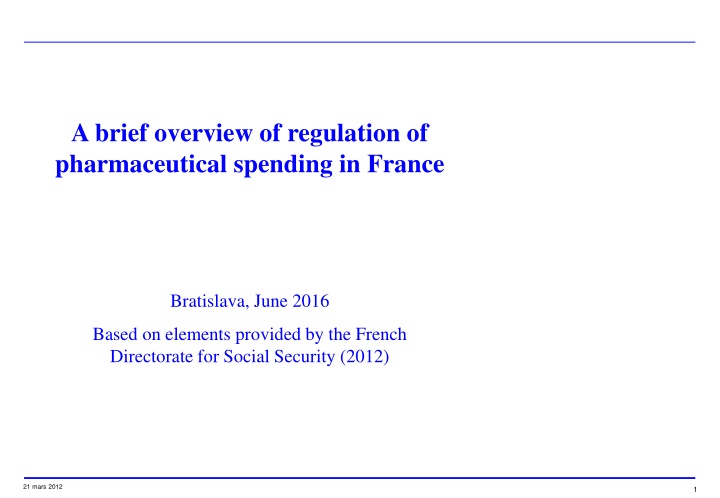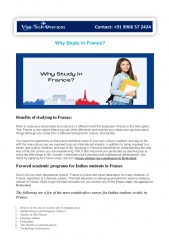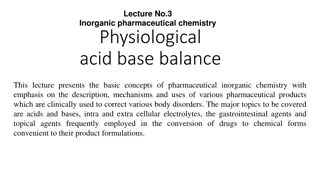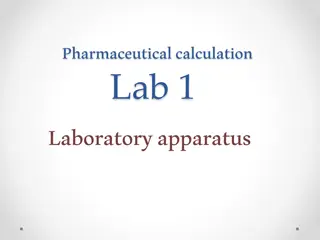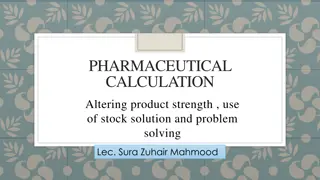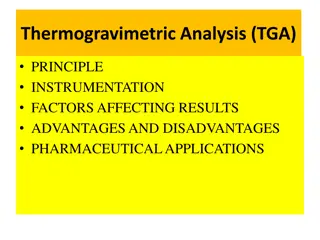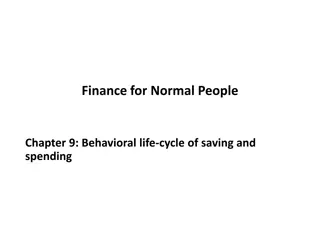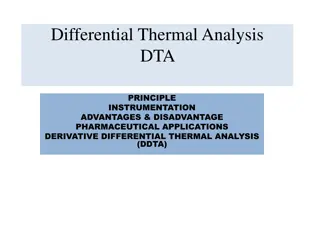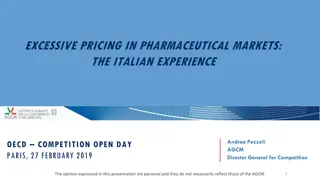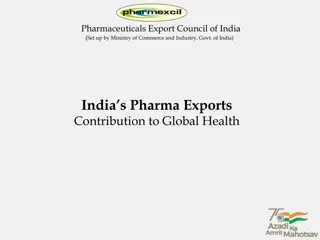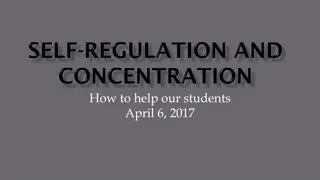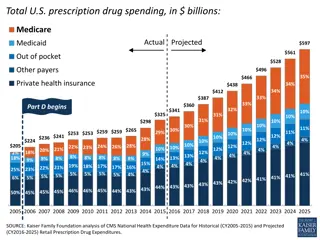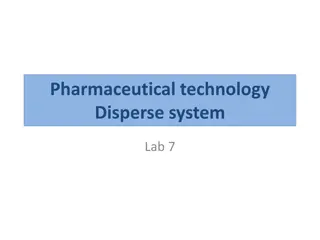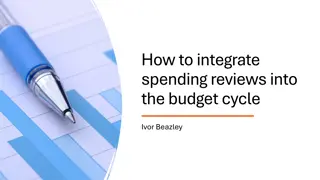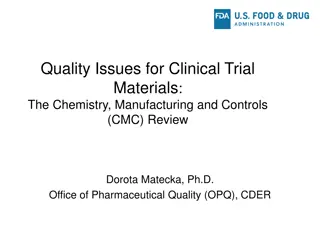Regulation of Pharmaceutical Spending in France: Overview
The regulatory framework for pharmaceutical spending in France involves a reimbursement decision process, health technology assessments, pricing negotiations, and decisions. The process includes evaluations based on the medical service rendered and improvement compared to existing therapies. Meetings are held regularly to ensure fair pricing and sustainability of social security finance.
Download Presentation

Please find below an Image/Link to download the presentation.
The content on the website is provided AS IS for your information and personal use only. It may not be sold, licensed, or shared on other websites without obtaining consent from the author.If you encounter any issues during the download, it is possible that the publisher has removed the file from their server.
You are allowed to download the files provided on this website for personal or commercial use, subject to the condition that they are used lawfully. All files are the property of their respective owners.
The content on the website is provided AS IS for your information and personal use only. It may not be sold, licensed, or shared on other websites without obtaining consent from the author.
E N D
Presentation Transcript
A brief overview of regulation of pharmaceutical spending in France Bratislava, June 2016 Based on elements provided by the French Directorate for Social Security (2012) 21 mars 2012 1
Legal and institutional framework Reimbursement decision process EMEA logo European Medicines Agency / Ansm Marketing Authorization HAS - Commission de transparence (CT) Health Technology Assessment Haute Autorit de sant Comit Economique des Produits de Sant (CEPS) Reimbursement rate Pricing Ministres de la sant et de la s curit sociale Ministries: inclusion in positive reimbursement list 21 mars 2012 2
Legal and institutional framework Health Technology Assessment: the decision driver Commission de transparence : the evaluation committee 20 voting members (healthcare professionals - mainly doctors) Meeting every 2 weeks An evaluation department of 25 people 1st index: Service m dical rendu (SMR) Cette appr ciation prend en compte l efficacit et les effets ind sirables du m dicament, sa place dans la strat gie th rapeutique, notamment au regard des autres th rapies disponibles, la gravit de l'affection laquelle il est destin , le caract re pr ventif, curatif ou symptomatique du traitement m dicamenteux et son int r t pour la sant publique. Les m dicaments dont le service m dical rendu est insuffisant au regard des autres m dicaments ou th rapies disponibles ne sont pas inscrits sur la liste (R163-3 du CSS) 4 levels: major or important, moderate, light, insufficient SMR = a driver for reimbursement rate Major or important medical service: 65% Moderate medical service: 30% Light medical service: 15% Insufficient medical service: no reimbursement 2nd index: Am lioration du service m dical rendu (ASMR) Measures the imrovement in medical service, compared to existing therapies ASMR = a driver for pricing About 300 new evaluations in 2010: 80% important medical service, 90% no improvement. Public evaluation, available on HAS website www.has-sante.fr 21 mars 2012 3
Legal and institutional framework Pricing negotiations and decisions: Comit Economique des Produits de Sant 10 members 10 votes: 1 Pdt + 1 Vice Pdt appointed by health, finance and economy ministers 4 ministries departments (DSS for social security finance, DGS for public health, DGCIS for industry policy, DGCCRF for competition) 3 representatives of national health insurance funds 1 representative of complementary health insurance funds Mission: pricing of reimbursed medicines regulation of pharmaceutical public spending Sustainability of social security finance + equal access to best existing medicines for all patients + fair pricing of pharmaceutical innovation Meeting every week + a team of 10 people preparing and following up decisions Pricing rules Law Framework agreement between CEPS and Industry Ministerial instructions 21 mars 2012 4
Legal and institutional framework Legal framework for pricing decisions: 2 main rules L.162-16-4 du CSS Le prix de vente au public de chacun des m dicaments [ ] est fix par convention entre l entreprise exploitant le m dicament et le CEPS [ ] ou, d faut, par d cision du comit , sauf opposition conjointe des ministres concern s qui arr tent dans ce cas le prix dans un d lai de 15 jours apr s la d cision du comit . La fixation de ce prix tient compte principalement de l am lioration du service m dical rendu apport e par le m dicament, le cas ch ant des r sultats de l valuation m dico- conomique, des prix des m dicaments m me vis e th rapeutique, des volumes de vente pr vus ou constat s ainsi que des conditions pr visibles et r elles d utilisation du m dicament. Prices = results of negotiated agreements between CEPS and companies Prices are set on a comparative basis with already reimbursed medicines, using index of medical improvement from HAS evaluation Agreements not only deal with prices but also with sales volumes and real-life use of medicines additional clauses R163-5 du CSS Ne peuvent tre inscrits sur la liste pr vue au premier alin a de l'article L. 162-17 [ ] les m dicaments qui n'apportent ni am lioration du service m dical rendu appr ci e par la commission mentionn e l'article R. 163-15 ni conomie dans le co t du traitement m dicamenteux If no medical imrovement reimbursement only with a price generating savings 21 mars 2012 5
Legal and institutional framework Framework agreement between CEPS and Pharmaceutical Industry Information exchange on sales For very innovative medicines (major, important or moderate improvement in medical service - ASMR): price no lower than UK, Germany, Spain and Italy prices Annual claw-back system + procedures (Ex: fast-track for innovative medicines), individual agreements model, For any information on CEPS activity + to read the framework agreement, see CEPS annual report (english version available) on www.sante.gouv.fr/les-activites- du -ceps.html 21 mars 2012 6
Tools for regulation Annual claw-back system Pharmaceutical taxes Price reductions and clawback on individual products Outlisting and co-payment increase Generics Distribution margins Prescription regulation 21 mars 2012 7
Tools for regulation Annual claw-back system A tax (L.138-10 du CSS). In case reimbursable pharmaceutical sales grow faster than K% (K = 1 in 2010, K = 0.5 in 2011 and 2012) For growth between K and K+0.5, tax rate = 50% For growth between K+0.5 and K+1, tax rate = 60% For growth above K+1, tax rate = 70% Split between companies on the basis of their sales (30%), their growth when above K% (40%) and their promotion budget (30%) 21 mars 2012 8
Tools for regulation Annual claw-back system This tax is not applicable to companies under agreement with CEPS but in that case, they fall under the annual claw back system introduced by the framework agreement between CEPS and industry K growth rate is split between pharmacotherapeutic classes into different growth rates, taking into account the specific trend of each class (patent expired, innovation ) If pharmaceutical sales exceed K growth rate, a contribution is collected in each class whose growth rate is exceeded. ( % of the exceeding growth) Split between companies selling drugs in each over-growing class, part on the basis of their sales and part on the basis of their excess turnover amount see growth rates applicable for each class in appendix 4 of CEPS annual report Ex: in 2010, K = + 1%, proton pump inhibitors = -7%, antidiabetic agents = +10% No contribution in 2010 (sales growth = 0.5% < 1%) nor in 2011 (sales growth = 0.3% < 0.5%) 21 mars 2012 9
Tools for regulation Pharmaceutical taxes Tax on wholesalers sales and direct-to pharmacies sales (L.138-1 du CSS) = 1.9% of sales + 2.25% of sales increase or decrease (min = 1.4%, max = 2.7%) : Tax on promotion spending (L. 245-1 du CSS) Tax on pharmaceutical sales (L. 245-6 du CSS) = 1% of sales (1.6 % from 2012): 21 mars 2012 10
Tools for regulation Price reductions and clawback on individual products Negotiated by CEPS Price reductions on patented drugs mainly in the following situations: Price consistency in pharmacotherapeutical classes Reduced european prices Revised medical evaluation (possible at any moment and at least every 5 years) Price reductions and/or clawback coming from specific clauses Volume clauses (can be pooled) Posology clauses Daily treatment cost clauses 21 mars 2012 11
Tools for regulation Outlisting and co-payment increase Outlisting only on the basis of medical evaluation (insufficient medical service SMR) 82 drugs in 2003 152 drugs in 2006 41 drugs in 2008 28 drugs in 2011 17 drugs in 2012 Co-payment increase 2010: creation of 15% reimbursement rate for light medical service drugs 2011: reduction from 35% to 30% of reimbursement rate for moderate medical service drugs But still 100% reimbursement for all medicines for patient with chronic or severe disease theoretical reimbursement mean rate = 66.10% but real reimbursement mean percentage = 76.25 % in 2010 21 mars 2012 12
Tools for regulation Generics Price reductions Price of generics = Price of original drug x% (40% in 2005, 50% in 2006, 55% in 2008, 60% in 2012) Price of original drug reduced by 15% (20% since 2012) when generics come to the market After 18 months, price of original drug reduced by 12.5% and price of generics reduced by 7% Tarifs forfaitaires de responsabilit (TFR) fixed accountability tariffs When substitution remains too low, original drugs are reimbursed on the basis of generic price Substitution targets to meet: 55% (60% since 2012) after 12 months, 60% (65% since 2012) after 18 months, 65% (70% since 2012) after 24 months, 80% after 36 months (since 2012) Incentives for generic substitution by pharmacists Substitution list published by AFSSAPS Same margin (in value) on generic than on original drug for pharmacists Maximum clawback = 17% on generics (2.5% on orginal drug) Generics = 25% of volumes, 13% of sales ( 2.6 billion) in 2010 on substitution list, Generics = 68% (only) of volumes, 54% of sales 21 mars 2012 13
Tools for regulation Distribution margins Public price = ex-factory price + wholesaler margin + pharmacist margin + VAT(2,1%) Wholesalers margin: Pour la partie du prix fabricant HT Comprise entre 0 et 22,90 22,91 et 150 150 et 400 au-del de 400 COEFFICIENT HT Before 2012: 0,993 0,06 0,02 0 Since 2012: flat margin = 6.68% of ex-factory price with 0.30 min and 30.06 max Pharmacists margin: Pour la partie du prix fabricant HT Comprise entre 0 et 22,90 22,91 et 150 au-del de 150 Forfait HT : 0,53 COEFFICIENT HT 0,261 0,10 0,06 Towards a fix markup per dispensing? 21 mars 2012 14
Tools for regulation Prescription regulation National health insurance funds acting to promote more efficient prescription Payment for performance system for doctors (since 2012) Targets of prescription on substitution list e-prescription on softwares under HAS certification Incentives for doctors Compulsory certification of prescription softwares since 2015 Compulsory prescription by active substance since 2015 21 mars 2012 15
